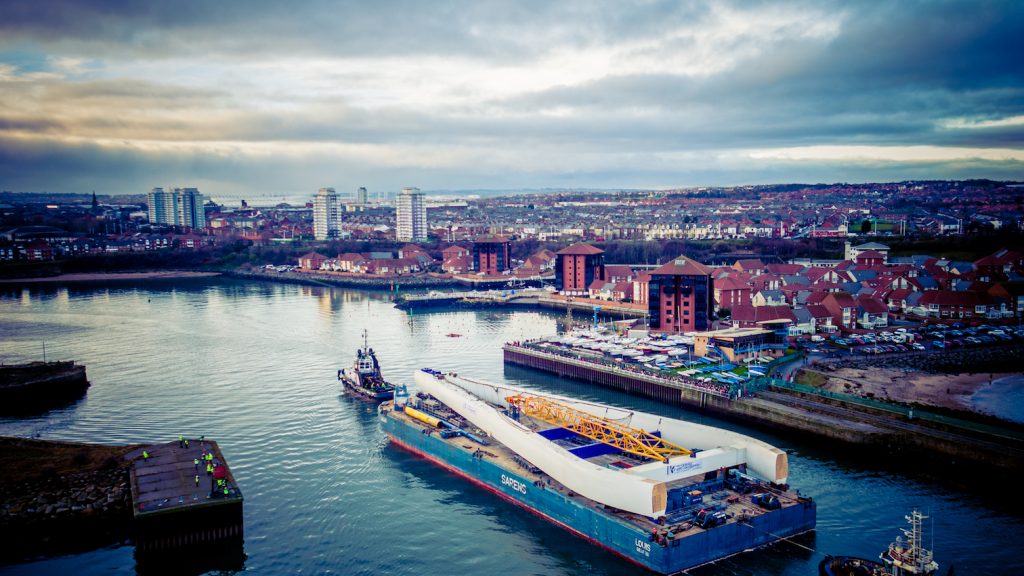 The striking 100m centrepiece to Sunderland’s new bridge has made its dramatic appearance in the city.
The striking 100m centrepiece to Sunderland’s new bridge has made its dramatic appearance in the city.
The impressive white structure, which is constructed from more than 1,000 tonnes of steel and 550 tonnes of concrete, arrived into the Port of Sunderland on Saturday afternoon with several hundred onlookers lining the banks of the River Wear to watch it arrive.
When the pylon arrived, it was met by harbour tug boats from the north east, about a mile off the Port entrance, and then towed past the Roker and New South piers before berthing at Greenwells Quay.
It will be moored at the port for several weeks while final preparations are carried out before it is transported three miles up the River Wear to the site of the new bridge between Pallion and Castletown.
 Whilst the pylon is moored at the port, members of the public will be able to see it from the roof of the National Glass Centre, which offers excellent views across the riverside and port area.
Whilst the pylon is moored at the port, members of the public will be able to see it from the roof of the National Glass Centre, which offers excellent views across the riverside and port area.
The pylon will form the centrepiece of the New Wear Crossing, which is on track to open in the spring of 2018. It will help attract investment into Sunderland, create new jobs and regenerate land along the River Wear.
Leader of Sunderland City Council Councillor Paul Watson said: “Seeing the pylon here in Sunderland for the first time makes me personally feel very proud of all the work that has been put in by a lot of people to turn this project into a reality.
“There is still a lot of work to be done, but I’d like to say thank you to everyone involved who has ensured that we have got this far – on time and within budget.”
Matthew Hunt, Port Director at the Port of Sunderland, said the unusual arrival in the port had caused quite a stir.
He said: “The Port of Sunderland plays host to ships and cargo from all over the world and, although some very famous ships were built on the Wear until the late 1980s, we’ve not had anything quite as unique as this pylon for a long time.
“Our team has been working hard with marine contractor Sarens, which has brought it here from Belgium, and we’ll certainly take good care of it while it’s in port for the next few weeks before it begins the final leg of its journey up the river.”
The new bridge will link Castletown to the north of the River Wear with Pallion to the south, and will have dual two-lane carriageways for vehicles, as well as dedicated cycle and pedestrian routes.
It will enhance public transport, as well as significantly improve the important transport links to the city centre and Port of Sunderland from the A19 and A1.
The bridge is being built on behalf of Sunderland City Council by Farrans Construction and Victor Buyck Steel Construction, known as FVB Joint Venture. The transportation of the pylon is being carried out by Sarens, a world leader in heavy lifting and engineered transport.
Carl Sarens, Technical Solutions and Engineering Director, said: “Sarens handles heavy and complex cargo worldwide, but being involved in the transport of the pylon, and then the raising of it on site in a few weeks’ time, is extremely complex and has required detailed in-house engineering expertise, working in close collaboration with the Farrans Victor Buyck team.
“The first challenge was slowly manoeuvring the pylon out of the fabrication yard and onto the two canal barges, which was a slow process because the ballast of the barges had to be carefully adjusted throughout the operation. Then taking it along the canals, under a series of low bridges, and into the Port of Ghent, where it was transferred to our larger, sea-going barge, required very precise and detailed planning.
“We are delighted to have brought the pylon to Sunderland. It is a magnificent structure, so we are looking forward to seeing it raised into place.”
Footage of the pylon leaving the Victor Buyck fabrication yard in Belgium and making its way to the Port of Ghent, followed by preparations for its journey across the North Sea, is here.
The next milestone in the bridge project will be the transportation of the pylon up the river to its permanent new home between Castletown and Pallion.
The transportation will be timed to coincide with the high tide and will be a precise and well-planned process, with the Louis barge that has transported the pylon across the North Sea accompanied by tugs as it makes its short journey to site.
Once it is in location at the construction site, and final checks have been made, it will then be raised into position at the centre of the new bridge.
The raising of the pylon, which will stand 105m above the River Wear, will be a hugely complex piece of engineering work that will take several hours to complete.
Details about the raising will be released nearer the time.


